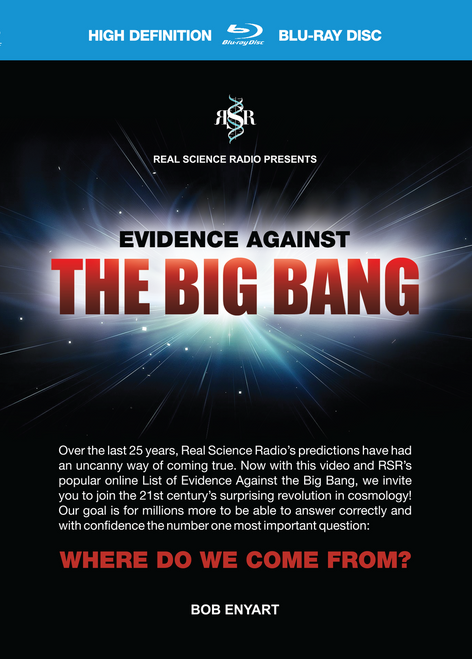* NASA's Planet Expert on the Nebular Hypothesis: Real Science Radio hosts Bob Enyart and Fred Williams begin today's program by contrasting (see below) the expectations versus the reality of Pluto's appearance and then introduce their List of Problems with Solar System Formation by quoting NASA's exoplanet database manager Caltech astronomer Mike Brown who said:
Before we ever discovered any [planets outside the solar system] we thought we understood the formation of planetary systems pretty deeply… It was a really beautiful theory. And, clearly, thoroughly wrong.
* List of Problems with Solar System Formation: Taken together, the impressive scientific discoveries that completely falsify the nebular hypothesis of solar system formation include these:
- exoplanets contradict the predictions of the nebular hypothesis theory
- our Sun is missing 99% of its expected spin (but angular momentum must be conserved)
- our Sun's rotation is seven degrees off the ecliptic (so did our orbits or the Sun tip?)
- planets would not form because as admitted in Nature in 2013, "according to standard theory [i.e., gravity], dust grains orbiting newborn stars should spiral into those stars rather than accrete to form planets”
- small bodies spiral in so quickly, in just a few hundred orbits, that Nature 2014 by anti-science blind faith claims "sub-metre-sized pebbles [grew] into 100-km-sized bodies, possibly in a single leap [??] ... through an unknown process."
- the dust grains and small rocks that do collide break apart instead of accreting to form planetesimals
- the "probably turbulent" protoplanetary disk "strongly stirs" accretions causing such collisions
- metre-sized bodies "take as little as 100 years to end up close to the star, where they quickly evaporate"
- the short lifetime of metre-sized bodies means there is a "limited opportunity" for them to grow
- the asteroid collisions alleged to form meteors would have littered the asteroid belt with micrometeoroids yet probes surprised NASA showing the debris diminished on their journey there
- the quintillions of small blobs of gas and dust imagined forming in space have no mechancism to compact themselves into the dense black rocks of meteorites
- the meteorites that cannot be explained cannot themselves be the explanation for the claimed meteoritic bombardment of the formation of planetesimals and planets
- even if the laws of physics enabled planet formation, 4.5 billion years is far too little time to build large planets, whether rocky or gaseous
- "a major embarrassment... Jupiter and Saturn... no one has a satisfying explanation of how they were made" Science 2002
- "Little is known about how microscopic dust particles can grow 14 orders of magnitude bigger to become a giant planet within the relatively short lifetime of the disk" Nature 2015
- the missing predicted uniform distribution pattern of solar system isotopes
- the extremely consistent Uranium isotope ratio, absurd if formed in space
- Earth doesn't produce Helium-3 yet it's too slippery for meteors to trap
- the other rocky planets don't have a lot of radioactivity in their crust as Earth does
- the missing expected uniform distribution of Earth's radioactivity
- the journal Earth and Planetary Science Letters 2004 sums up that "we do not really understand the physics of planetesimal formation, or how the planets came to have their present chemical compositions"
- the contrary-to-expectations fine-tuning of the solar system
- the many contrary-to-expectation transient events in the solar system
- as it would have been evolving, a faint young Sun can't explain the early Earth's warm climate
- that proponents are catastrophists trying to prop up the theory by claiming planetary catastrophes everywhere (list below)
- star formation has seemingly intractable physics problems (consider the Philae landing)
- contrary to an Oort or Kuiper origin, comets contain Earth-like minerals and rounded boulders - short-period comets still exist even though they have lifespans of only thousands of years
- the 1,346 trans-Neptunian objects with known orbits reach perihelion at the ecliptic
- the MNRAS published analysis showing simulations can never demonstrate both planet and asteroid formation
- peanut-shaped asteroids present a deep, unsolved mystery to secular astrophysicists
- Mercury has greater density than can be accounted for by evolutionary accretion
- NASA's 45-year lunar dust data collector shows that miles, not inches, should have accumulated in billions of years
- the rocky planets Mercury, Venus, Earth, and Mars would rotate far more slowly if accreted from a condensing nebula
- the origin of the gas giants Jupiter and Saturn has no "satisfying explanation" as per the journal Science in 2002
- by super nova and nebular hypotheses Earth and meteorites should but don't contain the same moly isotopic ratios
- the impact hypothesis for the formation of the Moon would have degassed the water, yet much is found there
- of the 170+ moons, as with others generally, those that would be explained as forming with their planets should have orbits lying near their equatorial plane but many do not
- 30 moons orbit retrograde (backwards)
- that Uranus rotates perpendicularly, Pluto rolls, and Venus rotates backwards.
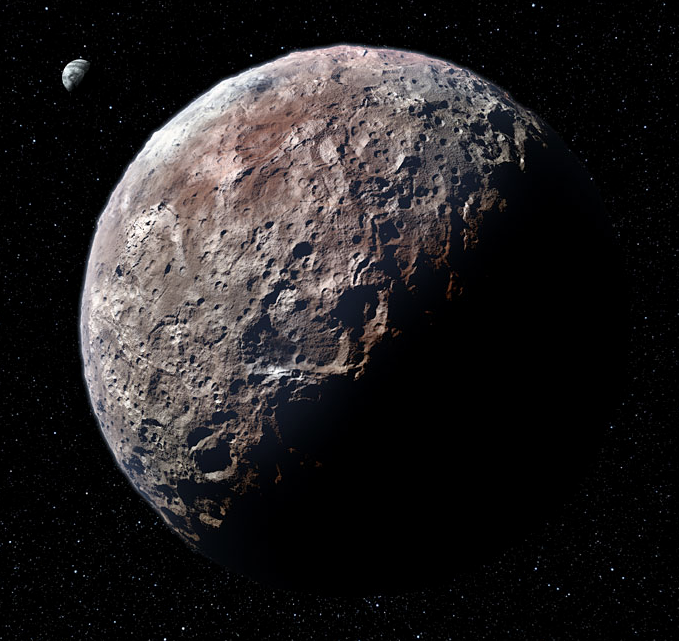 * March 2015 IAU Image Typical of Pluto Expectations: A few months before today's program, the International Astronomical Union used an image of Pluto (right) that represents the expectations of secular astronomers depicting a heavily cratered body grimy from sweeping up billions of years of space dust. This visual prediction failed. Likewise, from its physics to its major predictions, the entire theory of solar system formation, the nebular hypothesis, has failed.
* March 2015 IAU Image Typical of Pluto Expectations: A few months before today's program, the International Astronomical Union used an image of Pluto (right) that represents the expectations of secular astronomers depicting a heavily cratered body grimy from sweeping up billions of years of space dust. This visual prediction failed. Likewise, from its physics to its major predictions, the entire theory of solar system formation, the nebular hypothesis, has failed.
Exoplanets, with their masses, sizes, composition and orbital characteristics differ from what had been predicted for decades by the standard model of solar system formation, including with their retrograde orbits, highly inclined orbits and hot jupiters, effectively falsifying that model.
 * July 2015 What Pluto Actually Looks Like: The actual photos of Pluto from NASA's New Horizons mission will help make it obvious to thousands more people that the nebular hypothesis theory of origins is not helpful in understanding our solar system (or any other solar system for that matter). On today's program, Bob and Fred air an audio clip from a leading planetary scientist on the Passport to Pluto Science Channel update on NASA's mission acknowledging that even close to home, the predictions of mainstream (secular) astronomy mostly fail, and that's for planets nearest to home, in our very own solar system system.
* July 2015 What Pluto Actually Looks Like: The actual photos of Pluto from NASA's New Horizons mission will help make it obvious to thousands more people that the nebular hypothesis theory of origins is not helpful in understanding our solar system (or any other solar system for that matter). On today's program, Bob and Fred air an audio clip from a leading planetary scientist on the Passport to Pluto Science Channel update on NASA's mission acknowledging that even close to home, the predictions of mainstream (secular) astronomy mostly fail, and that's for planets nearest to home, in our very own solar system system.
* "Socks Blown Off": From RSR's List of Shocked Evolutionists, close-up photos show the youthful appearance of Pluto as do the images of its largest moon: "We originally thought Charon would be an ancient terrain covered in craters," said New Horizons team member Cathy Olkin. "So when we saw the pictures this morning, it just blew our socks off." :)
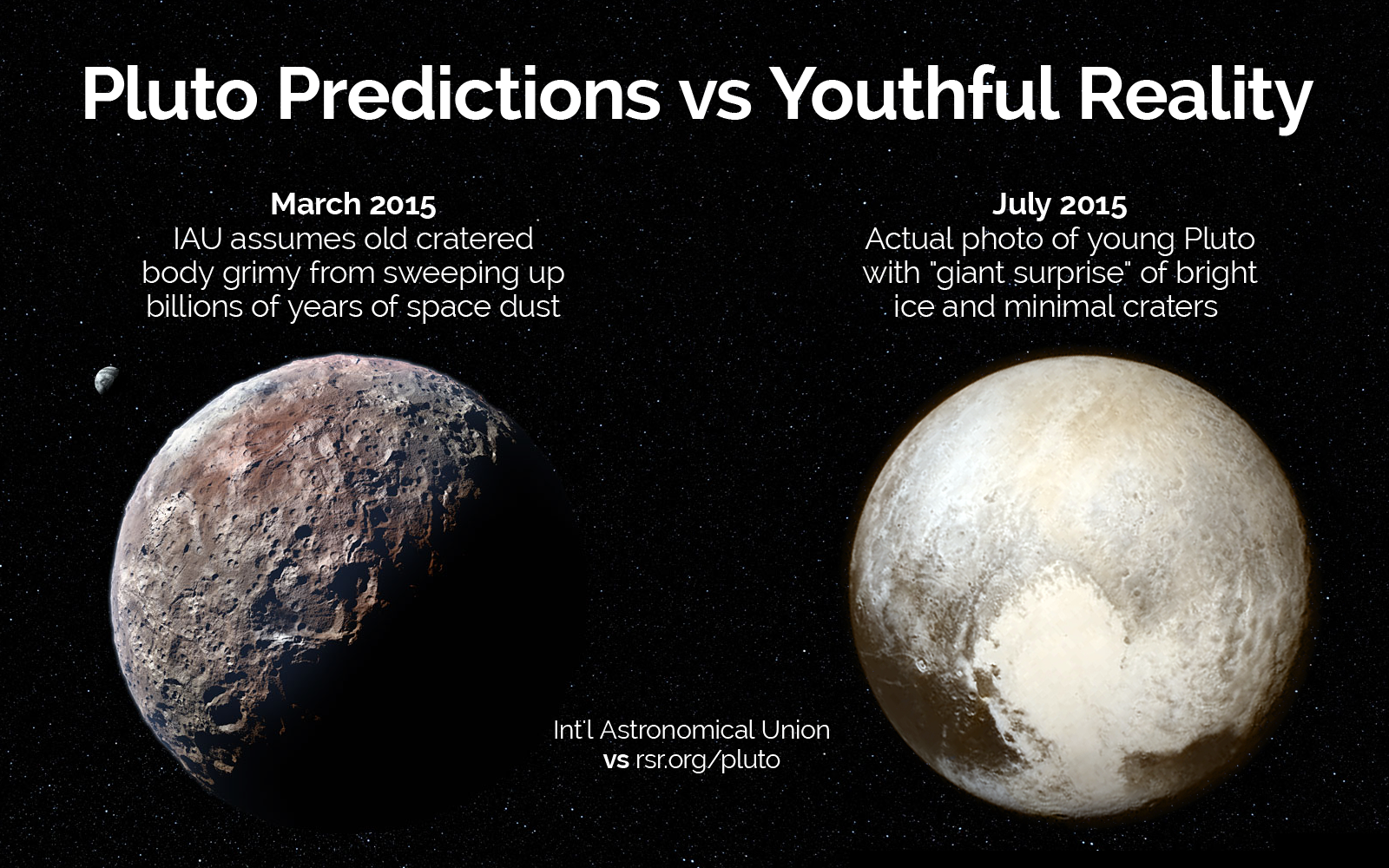
* Pluto Correctly Demoted: The International Astronomical Union correctly voted in 2006 to demote Pluto from it's previous status being considered a planet. Sometimes it requires knowledge of origins to accurately define something, such as, what a species is (or technically, what a kind is) and what a planet is. Planets are heavenly bodies created to orbit stars. In another basically accurate observation, space.com reported in 2018, "Pluto May Have Formed from 1 Billion Comets". Pluto is a TNO, and as at rsr.org/TNOs, these trans-Neptunian objects, like comets and asteroids, were not created objects but were made from solar system debris.

* Planet Formation Not Demonstrable by the Laws of Physics: Significant reports in 1972, 2000, 2002, 2009, 2013, and 2015, concur that the claim that the idea of planets accreting from collisions of dust and small rocks has not been demonstrated by application of the law of physics. The journal Nature in 2013 reported, "Planet formation is a paradox: according to standard theory, dust grains orbiting newborn stars should spiral into those stars rather than accrete to form planets." This intensifies what Scientifric American reported in 2000, "It turns out to be surprisingly difficult for planetesimals to accrete mass during even the most gentle collisions." More recently, the journal Nature in 2015 admitted, "But little is known about how microscopic dust particles can grow 14 orders of magnitude bigger to become a giant planet within the relatively short lifetime of the disk." And regarding the gas giants , in the journal Science in 2002, "Talk about a major embarrassment for planetary scientists. There, blazing away in the late evening sky, are Jupiter and Saturn—the gas giants that account for 93% of the solar system’s planetary mass—and no one has a satisfying explanation of how they were made." Notice that mainstream science outlets typically do not acknowledge severe problems with their most popular theories unless they have something, anything, to offer as a possible patch or replacement. If they were more objective, they would systematically list the problems with a favorite theory. Also, these science publishers, acting as a public relations service for the atheistic worldview, have adopted a ploy advocated by Eugenie Scott by which they present every new problematic discovery as "shedding new light onto how" such and such a thing originated, rather than forthrightly acknowledging that the latest discovery challenges their theory.
So the Corporation for Public Broadcasting, the BBC, Nova, Bill Nye, Lawrence Krauss, etc., wrongly built public confidence in the secular origins nebular hypothesis story. The longstanding claims of solar system formation were invented ad hoc to account for the particulars of our own solar system. Now that thousands of exoplanets are being discovered, the story telling will simply become, as with epicycles and levels of Darwinian selection, more complex. For more, see rsr.org/nebular-hypothesis-planet-formation-theory-decimated.
* Nature author kindly shares "Beautiful Theory" with RSR: Here's a reality check. Recall from above that NASA's Mike Brown described, "the formation of planetary systems" as "a really beautiful theory." Well, the journal Nature's News & Views feature published John Chambers Archaeology of the asteroid belt. A while back Chambers kindly provided Bob Enyart with a courtesy copy. Here's an excerpt:
Protoplanetary disks are predominantly composed of gas that can frustrate the growth of centimetre-to-metre-sized objects in two ways. Gas pressure typically decreases with distance from the star, and this pressure gradient means that gas orbits the star more slowly than a solid body does. As a result, solid objects experience a headwind, which causes them to drift towards the star. Drift rates increase with size and are greatest for metre-sized bodies, which take as little as 100 years to end up close to the star, where they quickly evaporate. The short lifetime of metre-sized bodies means there is a very limited window of opportunity for them to grow into planetesimals, for which radial drift is no longer a factor. Worse still, gas in a protoplanetary disk is probably turbulent. Centimetre-to-metre-sized bodies are strongly stirred by turbulent eddies, so they collide with one another at high speeds, causing them to break apart rather than stick together. For these reasons, it seems unlikely that objects will grow larger than about one metre as a result of gradual accumulation of dust grains.
We appreciate Chamber's candor. Realize though that those in mainstream science who want you to reject the Creator of the universe routinely misrepresent to the public the above paragraph's failed hypothesis as a "beautiful theory."
* Dec. 2, 2015 Issue of Nature: How the Solar System Didn't Form: From the Nature article, "Standard planet-formation models have been unable to reconstruct the distributions of the Solar System's small, rocky planets and asteroids in the same simulation. A new analysis suggests that it cannot be done." David Coppedge quotes the following from the article, and RSR has added the bracketed comments:
[MYTH:] About 4.5 billion years ago, the Solar System formed in a disk of gas and dust particles that surrounded the newly born Sun. The ‘giant’ planets (Jupiter, Saturn, Uranus and Neptune) formed first, within the few million years of the disk’s lifetime. Closer to the Sun, the small, rocky ‘terrestrial’ planets (Mercury, Venus, Earth and Mars) took tens of million years to form, by collisions of numerous smaller objects generated in the disk. Myriad small bodies formed the asteroid belt between the orbits of Mars and Jupiter.
[REALITY:] Despite decades of attempts, no computational realization of standard formation theories has reproduced the mass and orbital distribution of both the terrestrial planets and the asteroids. Writing in the Monthly Notices of the Royal Astronomical Society, Izidoro et al. show that this is not possible.
Enjoy also RSR's Planet Formation Theory Decimated.
* RSR's List of Claimed Planetary Catastrophes: Secular astronomers are planetary catastrophists. The secular world denies that a singular deluge catastrophe could have happened on Earth, yet because they deny that one catastrophe, atheist scientists constantly invoke far more catastrophic events, repeated planetary collisions, etc., everywhere else! Yet because the scientific community abhors a single flood catastrophe on Earth that explains our geological past, therefore they must constantly invoke planetary collisions, in the vast expanse of the volume of the solar system no less, to attempt to account for their materialist origin of the solar system:
- Mercury to explain its high density
- Venus to explain its retrograde rotation
- Venus to explain its lack of a moon
- Earth to explain the presence of its moon
- Earth to explain the presence of water (via lots of collisions with incoming comets and asteroids)
- Earth's moon to explain the stark difference between the near and far sides (maria pummeled mass cons vs. sprinkled)
- Earth to explain both the moon and the source of life's compounds; 2019 AAAS' journal Science Advances (but not always)
- Mars to explain its lack of an atmosphere (which it would have needed to maintain its surface oceans)
- Jupiter to explain missing planets closer to the Sun
- Saturn to explain its rings (a smashed moon, although the rings are perhaps 95% water, challenging that notion)
- Uranus to explain its tilt (Dec. 2018 update and tilt of its moons)
- Uranus' moon Miranda to explain its bizarre terrain (lately some claim tidal pumping instead but this would require Miranda to have had a different orbit than that observed)
- Pluto to explain its smooth, youthful surface
- multiple collisions are invoked to explain why a few inner rocky planets are spinning so rapidly on their axes
- Asteroids, incorrectly called "minor planets", to explain the many peanutroids and their high rotational angular momentum.
- A near stellar collision may be the cause for our planetary orbits being 7 degrees off the Sun's equator
- etc. (See the great astronomy video by Spike Psarris exposing evolutionists invoking these collisions to explain the features of our eight planets and their moons. And separately, consider that, as mentioned above, NASA, et al. expected that micrometeoroids would litter the asteroid belt but probe findings contradicted one of their fundamental expectations as instead, the debris diminished on their journey there, showing that Earth is actually in the solar system's Dust Belt, which is a retrodiction of a leading creation model.)

* Consider the Planetary Catastrophists' Earth/Mars Flood Irony: Secularists claim many planetary catastrophes (list above) while denying Earth's single flood catastrophe, even though our continents are covered more than a mile deep in sedimentary strata and the Earth is more than two-thirds covered in ocean water that averages 2.5 miles deep! Meanwhile, Mars is a global desert. Yet Nasa speaks of Mars' former Land of Noah (Noachis Terra) and its watery Noachian Epoch; when its fountains of the great deep "burst" forth onto the surface; with its proposed "global-scale", "catastrophic flood" or even "catastrophic floods that"¦ occurred "nearly simultaneously" which "merged into an ocean", "possibly global in extent." At a 2015 NASA press conference, NASA planetary scientist Geronimo Villanueva said of the entire planet, Mars had enough water to cover the planet to a depth of at least 137 meters, or about 450 feet. Another scientist, Jim Green, claimed that, "Two thirds of Mars' northern hemisphere was a huge ocean that may have been as much as a mile deep." The University of Edinburgh announcing a 2018 discovery spoke of "the Noachian" period of Martian history. So NASA, et al., (willfully ignorant of Earth's rsr.org/evidence for Noah's fountains of the great deep) think that ocean, which disappeared because, "Something happened on Mars and it suffered a major climate change and lost its surface water", helps explain why the planet is still moist. Their estimate, as in the journal Science, of "a global equivalent of water layer at least 137 meters deep" is wrong because they are misinterpreting the reason for the concentration of deuterium. (See rsr.org/radioativity and rsr.org/comets.) Yet the point is the irony that for the desert planet Mars the secular world will readily ponder a Noachian catastrophic flood possibly global in extent while pretending Earth's history could not possibly have included a global flood, despite the rsr.org/evidence.
* Help Grow Our Planetary Catastrophe List: Our list of more than a dozen planetary catastrophes (above) is not comprehensive. So if you know of another example, please consider sending it along to Bob@rsr.org. And creationists, please consider that Catastrophic Plate Tectonic (CPT) advocates (like those at AiG, ICR, and CMI) have a related problem (which is solved by Dr. Walt Brown's Hydroplate Theory of the fountains of the great deep) in explaining why bodies in the solar system, beginning with our own Moon, are so beat up; why the TNOs have the bizarre distribution they do; and why dangerous "flying bullet" meteoroids, asteroids, and comets exist. (See JPL's 2017 animation of asteroids and Earth's orbit.)
* Never-to-be-discovered devices needed to rescue old-earth origins models:
- The Oort Cloud, proposed in 1950 in hopes of explaining comets' short lifespans, does not exist
- The predicted Planet X, claimed shepherd of TNOs, way more massive than Earth and beyond Pluto, does not exist
- Dark matter, proposed in 1932 by the astronomer who proposed the Oort Cloud and later by others, does not exist
- Dark energy does not exist; inflatons do not exist; dark radiation does not exist. Instead, God exists.
* Many unexpected transient events in our solar system: To see our complete list with links to sources, please check out our 2016 program, RSR's List of the Transient Events in the Solar System! If the solar system actually were 4.55 billion years old (that third significant digit is added by evolutionists as a psychological device to convince the public of a fictitious precision), by now it should have reached a stasis. Instead, scientists observe a great number of short-lived occurrences (transient phenomena) including:
- Mercury: rapid decline of its magnetic field
- Venus: recent volcanic eruptions and the apparent significant slowing of rotation
- Earth: rapid decline of magnetic field; inner core melting; black smokers; rapidly changing "ancient" geologic features
- Moon: rsr.org/moon#TLP cites unexpected heat, dust, molten outer core, volcanism, radon & helium emissions, recession, and LaGrange clouds
- Mars: eruption of apparent water vapor plumes to 200 kilometers and outgassing of its moons Phobos and Deimos
- Jupiter: moon Europa erupting and Io giving off 10x more heat than tidal pumping can explain
- Saturn: rings are young and changing and Enceladus is erupting (hear RSR interview former JPL systems administrator)
- Comets: short-period comets (and the Oort cloud will never be found, because it does not exist)
- Asteroids: that outgas, that have six tails, that look like comets, etc., see phys.org, NASA, EarthSky, etc.
- TNOs: Trans-Neptunian Objects are thousands of years old because millions of years would have randomized their perihelions
- And please send any examples that you may come across to us at Bob@rsr.org.
* Transient Events in the Universe: Here is an exercise for the student. Do research to learn whether or not there are any transient events in the universe, that is, whether there are any universe-wide temporary phenomenon that we are observing right now! (Hint: Theoretical physicist Lawrence Krauss may have an answer.)
* Help Us Reach a Small YouTube Milestone: RSR's newly attended to Bob Enyart YouTube channel is about to hit 75,000 views. Please click to check out a video, and we should hit that goal by Saturday, July 18th!
* Get a Great Astronomy Resource: Get RSR's Evidence Against the Big Bang video on Blu-ray, DVD, and as a download! You may also love Spike Psarris DVD What You Aren't Being Told About Astronomy and Vol. II, Our Created Stars and Galaxies! These are hands down the best astronomy videos ever made! You'll agree, or your money back! Also, purchasing them from us here at RSR will help us keep our radio show on the air reaching more and more people! And have you browsed through our Science Department in our KGOV Store? (That's what we call it.) Check out also Bob Enyart’s Age of the Earth Debate against a well-known geophysicist and a University of Colorado mathematician who are members of the Denver chapter of Reasons to Believe. And we ask you to consider getting a Bob Enyart Live monthly subscription, in audio or video, of one of our really fun and educational resources!
Finally, please consider helping us reach our vitally important July 2015 Telethon goal of $30,000! We're currently at $11,600, and you can help by clicking on the Store tab above, and then making a one-time or monthly donation, or signing up for a subscription or browsing our Science Department for some great science resources!
* Helium-3, Another of the Evolution's Inexplicable Problems: NASA and all those who still promote the discredited nebular hypothesis of solar system formation have more faith in their theory than they do in basic physics. Another of many more problems for evolutionary astronomers is that Earth should not be loaded with helium-3 (relatively speaking), but it is!
"But the questions of how gas from the solar nebula was trapped in the solid parts of growing planets, and how the gas was preserved through early accretionary events, will certainly test our models of accretion." Chris J. Ballentine, A Dash of Deep Nebula on the Rocks, Nature, 2012
See more here and here about the problem helium-3 presents to old-earth materialists.
* Missing Uniform Distribution of Radioactivity: The materialist theory on the origin of the elements in the periodic table claims that all of our radioactive elements were created in the explosion of stars (no longer supernovas, but now nuetron stars and even black holes), but that would predict a relatively uniform distribution on Earth, at least throughout the crust, and possibly the mantle too. So in today's otherwise contentious interview, Krauss agreed with Enyart's statement that 90% of Earth's radioactivity (uranium, thorium, etc.) is located in the continental crust, and Krauss added, a mystery for him, that it tends to concentrate around granite! That is, that 90% is not in the mantle nor in the enormous amount of the crust which lies under the oceans, but our planet's radioactivity is concentrated in 1/3rd of 1% of the Earth's mass, in the continental crust. (Further, the release of it's heat has not yet reached a steady state.) Krauss offered a partial explanation: that uranium was originally evenly distributed throughout (an alleged) molten earth but being a large atom, it floated toward the surface. This the bias of this physicist led him to forget, apparently, that it is density, and not size, that causes things to float. Even denser than gold, uranium is one of the most dense elements (excluding atheists and other manmade phenomena). Further, for argument's sake, that would only explain the relative absence of radioactivity deep in the Earth, but would not explain uranium's distancing itself from the mantle and from the oceanic crust, nor its affinity for the continents and even, of all things, for granite. Further, under Krauss' belief in the widespread falsehood that the planet was once molten, if so, then the gold in the crust should have sunk to the core! The creationists, on the other hand, have a theory based on observational science as to why radioactivity is concentrated around granite.
* Absurd Consistency of Uranium Isotopes IF Formed in Space: Google: origin of Earth's radioactivity. The top-ranked result is Walt Brown's hydroplate theory, explained at rsr.org/radioactivity. From MIT Ph.D. Brown:
The isotopes of each chemical element have almost constant ratios with each other. ... Why is the ratio of 235U to 238U in uranium ore deposits so constant almost everywhere on Earth? One very precise study showed that the ratio is 0.0072842, with a standard deviation of only 0.000017. Obviously, the more time that elapses between the formation of the various isotopes (such as 235U and 238U) and the farther they are transported to their current resting places, the more varied those ratios should be. The belief that these isotopes formed in a supernova explosion millions of light-years away and billions of years before the Earth formed and somehow collected in small ore bodies in a fixed ratio is absurd. Powerful explosions would have separated the lighter isotopes from the heavier isotopes.
Some radioisotopes simultaneously produce two or more daughters. When that happens, the daughters have very precise ratios to each other, called branching ratios or branching fractions. Uranium isotopes are an example, because they are daughter products of some even heavier element. Recall that the Proton-21 Laboratory has produced superheavy elements that instantly decayed. Also, the global flux of neutrons during the flood provided nuclei with enough neutrons to reach their maximum stability. Therefore, isotope ratios for a given element are fixed. Had the flux of neutrons originated in outer space, we would not see these constant ratios worldwide. Because these neutrons originated at many specific points in the globe-encircling crust, these fixed ratios are global.
"Walt Brown is the Isaac Newton of our day." -Bob Enyart
* Meteorite Moly Isotope Variation: From Dr. Brown:
Meteorites contain different isotopes of the chemical element molybdenum, each isotope having a slightly different atomic weight. If, as evolutionists teach, a swirling cloud of gas and dust mixed for millions of years and produced the Sun, its planets, and meteorites, then each meteorite should have about the same combination of these molybdenum isotopes. Because this is not the case, meteorites did not come from a swirling dust cloud or any source that mixed for millions of years.
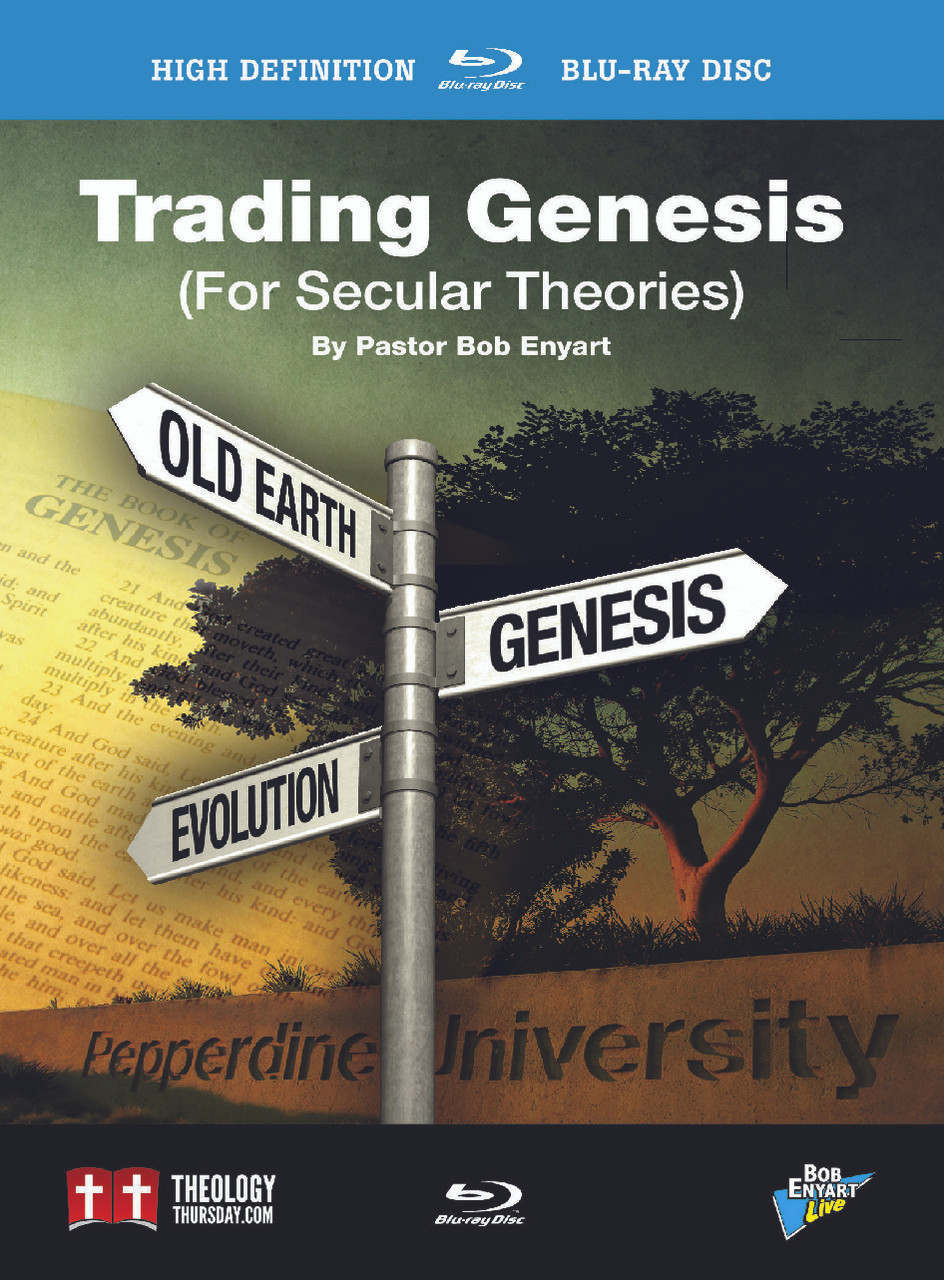 Today's Resource:
Today's Resource:
Trading Genesis (for Secular Theories)
Pepperdine University in California has long enjoyed a reputation as a leading conservative Christian institution. Today, however, Pepperdine’s faculty teaches theistic evolution. Though affiliated with the Church of Christ, the theistic evolution of the school’s science and theology professors is indistinguishable from the methodological naturalism of the atheist.
In 2015, the administration denied a request by some Pepperdine alumni to present a lecture on biblical creation. Not deterred, both longtime and recent graduates organized their own creation-evolution conference on the school’s campus and advertised it in the Malibu Times newspaper.
The organizers invited Bob Enyart, the host of Denver-based Real Science Radio, to speak at the event held concurrently with the school's heavily-attended Bible Lectureship series. Enyart demonstrated with seven examples that the atheistic materialist worldview does not even have a theory of origins for anyone to side with. And thus, Pepperdine University has traded away special creation (and many other biblical teachings, also listed in this presentation) for absolutely nothing.
See also Bob Enyart's debate with an acclaimed British author at rsr.org/theistic-evolution, more about this Pepperdine event at rsr.org/trading-genesis, and more fun science facts at rsr.org/young-earth.
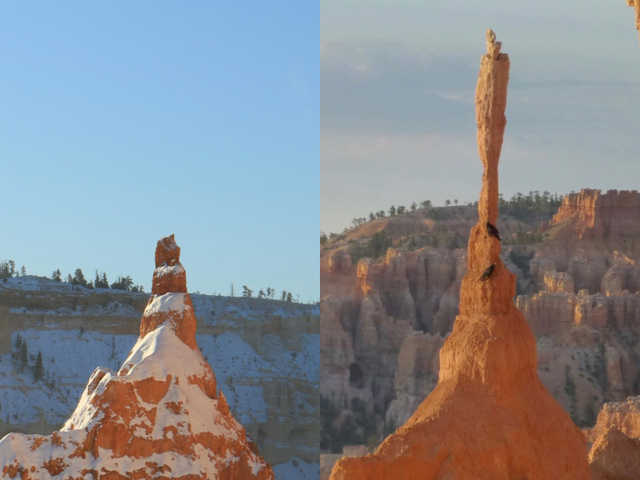 * Earth's Rapidly Collapsing "Ancient" Geologic Features: In 2017, RSR broadcast our own list of rsr.org/earths-collapsing-ancient-features including that Bryce National Park's famous rock spire called the Sentinel has fallen.
* Earth's Rapidly Collapsing "Ancient" Geologic Features: In 2017, RSR broadcast our own list of rsr.org/earths-collapsing-ancient-features including that Bryce National Park's famous rock spire called the Sentinel has fallen.
* See All of Our Great RSR List Shows: We think you'll love them! (Or, if you hate them, they just might change your life.) Check them out at rsr.org/list-shows.

